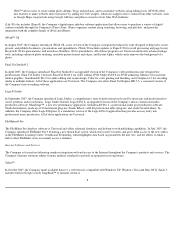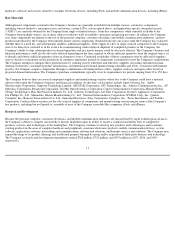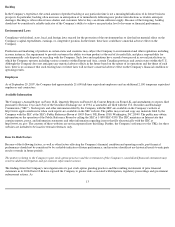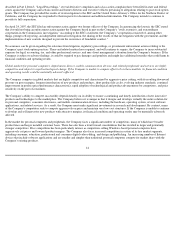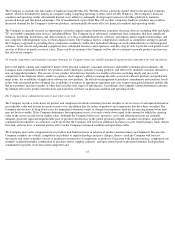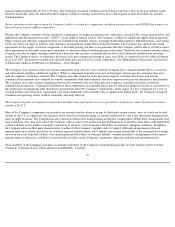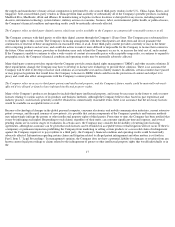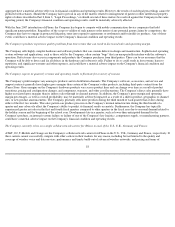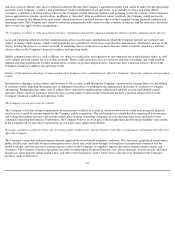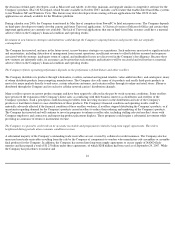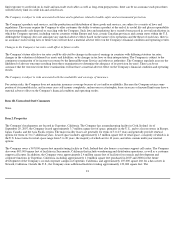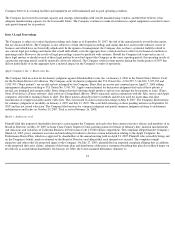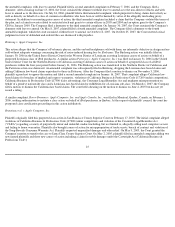Apple 2007 Annual Report Download - page 18
Download and view the complete annual report
Please find page 18 of the 2007 Apple annual report below. You can navigate through the pages in the report by either clicking on the pages listed below, or by using the keyword search tool below to find specific information within the annual report.
The Company is currently the only maker of hardware using the Mac OS. The Mac OS has a minority market share in the personal computer
market, which is dominated by makers of computers using competing operating systems, most notably Windows. The Company's financial
condition and operating results substantially depend on its ability to continually develop improvements to the Mac platform to maintain
perceived design and functional advantages. Use of unauthorized copies of the Mac OS on other companies' hardware products may result in
decreased demand for the Company's hardware products, and materially adversely affect its financial condition and operating results.
The Company is currently focused on opportunities related to digital content distribution, consumer electronic devices, including iPod and Apple
TV, and mobile communication devices, including iPhone. The Company faces substantial competition from companies that have significant
technical, marketing, distribution, and other resources, as well as established hardware, software, and digital content supplier relationships, and
also competes with illegitimate ways to obtain digital content. The Company expects competition to intensify as competitors attempt to imitate
the Company's approach to providing these components seamlessly within their individual offerings or work collaboratively to offer integrated
solutions. Some current and potential competitors have substantial resources and experience, and they may be able to provide such products and
services at little or no profit or even at a loss. There can be no assurance the Company will be able to continue to provide products and services
that effectively compete.
To remain competitive and stimulate customer demand, the Company must successfully manage frequent product introductions and transitions.
Due to the highly volatile and competitive nature of the personal computer, consumer electronics and mobile communication industries, the
Company must continually introduce new products and technologies, enhance existing products, and effectively stimulate customer demand for
new and upgraded products. The success of new product introductions depends on a number of factors, including timely and successful
completion of development efforts, market acceptance, the Company's ability to manage the risks associated with new products and production
ramp issues, the availability of application software for new products, the effective management of purchase commitments and inventory levels
in line with anticipated product demand, the availability of products in appropriate quantities and costs to meet anticipated demand, and the risk
that new products may have quality or other defects in the early stages of introduction. Accordingly, the Company cannot determine in advance
the ultimate effect new product introductions and transitions will have on financial condition and operating results.
The Company faces substantial inventory and other asset risk.
The Company records a write-down for product and component inventories that have become obsolete or are in excess of anticipated demand or
net realizable value and accrues necessary reserves for cancellation fees for orders of products and components that have been cancelled. The
Company also reviews its long-lived assets for impairment whenever events or changed circumstances indicate the carrying amount of an asset
may not be recoverable. If the Company determines that impairment exists, it records a write-down equal to the amount by which the carrying
value of the assets exceeds its fair market value. Although the Company believes its inventory, asset, and related provisions are currently
adequate, given the rapid and unpredictable pace of product obsolescence in the global personal computer, consumer electronics, and mobile
communication industries, no assurance can be given that the Company will not incur additional inventory or asset related charges. Such charges
have had, and may have, a material adverse effect on the Company's financial condition and operating results.
The Company must order components for its products and build inventory in advance of product announcements and shipments. Because the
Company's markets are volatile, competitive and subject to rapid technology and price changes, there is a risk the Company will forecast
incorrectly and order or produce excess or insufficient inventories of components or products. Consistent with industry practice, components are
normally acquired through a combination of purchase orders, supplier contracts, and open orders based on projected demand. Such purchase
commitments typically cover forecasted component and
15





